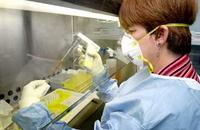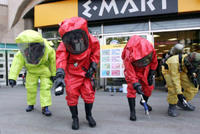-
Scientists develop safe method for research on deadly flu viruses

In 2012, scientists around the world agreed to a worldwide, yearlong voluntary moratorium on research into the deadly H5N1 bird flu. The ban came after several scientific teams successfully altered the H5N1 viral genome to enable airborne transmission of the bird flu between ferrets — mammals considered a good research model for humans. The public health concern was that altered H5N1 could escape the lab, infect and spread among humans, producing a global pandemic. There was also concern that terrorists would use the altered H5N1 viral genome in large-scale bioterror attacks. Researchers have now been able to turn molecules in human lung cells into viral scissors that cut H5N1 bird flu and similar bugs into pieces. This dismantling of the viral genome in human lung cells will ensure safe research on deadly strains of influenza.
-
-
Lawmakers criticize FDA, CDC for Cyclospora outbreak foot-dragging
Lawmakers want to know why it has taken so long for food-safety authorities to respond to the cyclospora outbreak which, so far, has sickened at least 418 people in sixteen states. They also want to know why the FDA and CDC have been tight-lipped about the specific products carrying the parasite — health authorities in Nebraska and Iowa have pointed to bagged salad containing romaine and iceberg lettuce as well as carrots and cabbage as the source – and who is the manufacturer of the contaminated products.
-
-
North Carolina’s biothreat warning system receives funding
The North Carolina Bio-Preparedness Collaborative (NCB-Prepared), a project to develop an early warning system to detect biothreats, has received $3 million in funding. The goal of NCB-Prepared project is to develop a statewide system that can detect and alert health officials and first responders within hours of an outbreak indicating a bioterror attack, contagious disease or illness, food-borne illness, and other biothreats.
-
-
U.S., South Korea teaming up for bioterrorism exercise
Officials from the United States and South Korea were in Seoul, South Korea last month for the third annual joint anti-bioterrorism exercise in Seoul. Around eighty U.S. officials and between 120 and 130 South Korean military officials participated in the tabletop exercise.
-
-
Protecting drinking water systems from deliberate contamination

The importance of water and of water infrastructures to human health and to the running of the economy makes water systems likely targets for terrorism and CBRN (chemical, biological, and radionuclide) contamination. Reducing the vulnerability of drinking water systems to deliberate attacks is one of the major security challenges. An international project has developed a response program for rapidly restoring the use of drinking water networks following a deliberate contamination event.
-
-
New microfluidic chip useful in counterterrorism, water and food safety
A new process for making a three-dimensional microstructure that can be used in the analysis of cells could prove useful in counterterrorism measures and in water and food safety concerns. Researchers developed a new microfabrication technique to develop three-dimensional microfluidic devices in polymers. Microfluidics deals with the performance, control, and treatment of fluids that are constrained in some fashion.
-
-
Fast, reliable identification of pathogens
Life-threatening bacterial infections cause tens of thousands of deaths every year in North America, but current methods of culturing bacteria in the lab can take days to report the specific source of the infection, and even longer to pinpoint the right antibiotic that will clear the infection. Researchers have created an electronic chip that can analyze blood and other clinical samples for infectious bacteria with record-breaking speed.
-
-
Letters containing ricin sent to Mayor Michael Bloomberg, gun-control advocacy group

Two letters sent to Mayor Michael Bloomberg – one to his office in New York, the second to the Washington, D.C. offices of Mayors Against Illegal Guns, a non-profit gun-control group he has founded — contained traces of the deadly poison ricin.
-
-
Spokane, Wash. biolab could be closed due to budget cuts
Just two weeks ago, law enforcement agencies credited a bioterrorism laboratory in Spokane, Washington with quickly identifying the substance in several letters mailed to people in town as ricin. These same agencies now say that the biolab could close as a result of budget cuts.
-
-
Smartphone turned into handheld biosensor

Scientists and physicians in the field could soon run on-the-spot tests for environmental toxins, medical diagnostics, food safety and more with their smartphones. Researchers have developed a cradle and app for the iPhone that uses the phone’s built-in camera and processing power as a biosensor to detect toxins, proteins, bacteria, viruses, and other molecules.
-
-
Oregon drills first responders for bioterrorism attack

A three day drill called the Portland Area Capabilities Exercise (PACE), simulating a terrorist attack involving a biological weapon, will take place across fifty different facilities and sixty-five jurisdictions in the state of Oregon.
-
-
Ricin can kill, but there are more potent bioterror weapons
Ricin was in the headlines a few weeks ago, when envelopes containing the poison were mailed to President Obama, Senator Roger Wicker (R-Mississippi), and a Mississippi judge. The threat from ricin is low, however, because ricin cannot poison someone through contact with the skin. To be poisoned, an individual would have to ingest or inhale traces of the poison.
-
-
Quickly identifying chemical, biological warfare agents
For more than fifty years, researchers have been studying exactly how aspirin affects the human body. Despite thousands of publications on the topic, our understanding is still incomplete. Meanwhile, novel chemical and biological weapons have historically been mass produced within a year of discovery. Using current methods and technologies, researchers would require decades of study to gain a robust understanding of how new threat agents exert effects on human biological systems. DARPA wants to close this capability gap, which leaves U.S. forces vulnerable.
-
-
Pennsylvania emergency professionals receive WMD training
The Center for Domestic Preparedness (CDP) in Alabama hosted more than a hundred emergency professionals from the Pennsylvania South Central Mountains Regional Task Force’s Health and Medical Committee for in-depth response-to-WMD training.
-
-
New detection test to improve food safety, bioterrorism defense
Sales of chicken products in China plummeted recently during an outbreak of a deadly new strain of bird flu. From bird flu to mad cow disease, numerous food scares have made global headlines in recent years.Scientists develop new detection technique which wouldmake food contamination testing more rapid and accurate. The detection test could also accelerate warnings after bioterrorism attacks.
-
- All
- Regional
- Water
- Biometrics
- Borders/Immig
- Business
- Cybersecurity
- Detection
- Disasters
- Government
- Infrastructure
- International
- Public health
- Public Safety
- Communication interoperabillity
- Emergency services
- Emergency medical services
- Fire
- First response
- IEDs
- Law Enforcement
- Law Enforcement Technology
- Military technology
- Nonlethal weapons
- Nuclear weapons
- Personal protection equipment
- Police
- Notification /alert systems
- Situational awareness
- Weapons systems
- Sci-Tech
- Sector Reports
- Surveillance
- Transportation
Advertising & Marketing: advertise@newswirepubs.com
Editorial: editor@newswirepubs.com
General: info@newswirepubs.com
2010-2011 © News Wire Publications, LLC News Wire Publications, LLC
220 Old Country Road | Suite 200 | Mineola | New York | 11501
Permissions and Policies
Editorial: editor@newswirepubs.com
General: info@newswirepubs.com
2010-2011 © News Wire Publications, LLC News Wire Publications, LLC
220 Old Country Road | Suite 200 | Mineola | New York | 11501
Permissions and Policies
